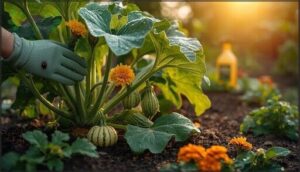This site is supported by our readers. We may earn a commission, at no cost to you, if you purchase through links.
A single cold snap can wipe out weeks of careful planning in a summer squash patch, but rushing to plant too early can cost you almost half your harvest before you even begin. Timing and technique matter more than most gardeners realize—especially when one wrong move can mean stunted plants or sudden pest invasions.
If you want thriving, productive squash, it pays to know the science behind soil temperature, sunlight, and water. With a few practical summer squash plant care tips, you can turn a tricky crop into a reliable staple, no matter how unpredictable the season gets.
Table Of Contents
- Key Takeaways
- Essential Summer Squash Planting Tips
- Watering and Feeding Summer Squash
- Preventing Pests and Disease in Summer Squash
- Top 5 Products for Summer Squash Care
- Frequently Asked Questions (FAQs)
- What is the secret to growing squash?
- How do you take care of summer squash plants?
- Should I cut the yellow leaves off my squash plant?
- What does an overwatered squash plant look like?
- How do you harvest summer squash correctly?
- Can summer squash grow well in containers?
- How to prune summer squash for better airflow?
- What companion plants benefit summer squash growth?
- How to store harvested summer squash effectively?
- When should summer squash be harvested?
- Conclusion
Key Takeaways
- Timing your planting after the last frost when soil reaches at least 70°F prevents up to 40% germination loss and sets the foundation for a successful harvest.
- Deep watering once or twice weekly—delivering 1 to 2 inches that penetrates 6 to 8 inches down—builds stronger roots and prevents fungal diseases better than frequent shallow sprinkling.
- Combining drip irrigation with mulch can cut water use by 41% while keeping leaves dry, which is your primary defense against powdery mildew and other fungal problems.
- Daily harvest checks when fruits reach 6 to 8 inches long keep plants producing continuously, since leaving oversized squash on the vine signals the plant to stop setting new fruit.
Essential Summer Squash Planting Tips
Getting summer squash off to a strong start means timing your planting just right and giving your plants the conditions they need to thrive. You’ll want to pay attention to soil temperature, sunlight, spacing, and whether to start seeds indoors or sow them directly in the garden.
Here’s what you need to know to set up your summer squash for success.
Best Time to Plant Summer Squash
Once the last frost date passes and your soil warms to at least 70°F, you’re ready to plant summer squash seeds. Regional planting windows vary—zone 7b gardeners can start in April, while colder areas wait until late May.
Checking soil temperature matters because planting too early cuts germination rates by 40%. Smart timing prevents crop turnover issues and reduces climate impacts on your harvest.
For proper soil pH between 5.8 and 7, guarantee growth that’s best.
Full Sun and Temperature Requirements
Your squash plants need 6 to 8 hours of direct sunlight daily, though 8 to 10 hours maximizes yields. Maintaining temperatures between 65°F and 75°F fosters healthy growth, while heat stress above 95°F can drop flowering rates by 50%. Frost damage will kill seedlings outright, and chilling below 45°F harms stored fruit.
Summer squash thrives with 8 to 10 hours of sun and temperatures between 65°F and 75°F, but heat or frost quickly threatens yields
Understanding that fruiting vegetables need at least six hours of direct sun is also critical. This sunlight duration and temperature range correlation directly affects your harvest success.
Soil Preparation and PH Levels
Now that your plants will get enough light, you need to focus on what’s beneath them. Aim for a pH between 6.0 and 7.5 to release nutrients your squash craves. Before planting, work 2 to 5 inches of compost into your soil to boost texture and health:
- Test pH and amend acidic soil with lime months ahead
- Mix balanced fertilizer at 2 pounds per 100 square feet
- Make sure soil temperature stays above 60°F for germination
- Choose well-drained, loamy soil rich in organic matter
Spacing and Planting Depths
Once you’ve dialed in your soil temperature and pH, best spacing and planting depth become your next priorities. Bush vs. vine varieties dictate how much room you’ll need—bush types thrive at 18 to 24 inches apart, while vining forms demand 3 to 5 feet.
Plant seeds 1 to 1.5 inches deep for reliable germination and yield optimization in your summer squash patch.
Direct Sowing Vs. Indoor Starting
When planting summer squash, you’ll face a trade-off between two solid approaches. Direct sowing avoids transplant shock and root disturbance while offering resource efficiency, but germination rates may vary outdoors. Indoor seed starting gives you a 3-4 week head start with predictable flowering and higher success rates. Consider your climate, available time, and growing summer squash goals:
- Direct sowing works best in reliably warm soil above 70°F
- Indoor starting protects seeds from pests and weather extremes
- Transplanting requires hardening off to minimize stress
Watering and Feeding Summer Squash
Your summer squash plants are heavy feeders that need steady moisture and nutrition to produce those abundant harvests you’re hoping for. Getting the watering and feeding right isn’t complicated, but it does require some attention to detail.
Let’s look at the key practices that will keep your plants thriving from planting to harvest.
Maintaining Consistent Moisture
Think of your squash roots like a sponge—they work best when they stay evenly damp, not soggy or bone-dry. You’ll want to maintain soil moisture between 10–15 cbars using drip irrigation systems for best root health and water efficiency.
Regional effects matter too, so adjust your irrigation scheduling based on local rainfall and temperature. Mulch helps lock in soil health while preventing wild moisture swings.
Deep Watering Vs. Frequent Watering
Your watering schedule directly affects root penetration, yield impact, and disease control in your summer squash. Deep watering once or twice a week—applying 1 to 2 inches that reaches 6 to 8 inches down—beats frequent shallow sprinkling every time.
This approach improves water efficiency, encourages stronger roots, and keeps leaves drier to prevent fungal problems.
Your vegetable garden care becomes simpler, and your squash plant care delivers better harvests.
Drip Irrigation and Mulching Techniques
Combining drip irrigation with mulch can slash your water use by 41% while boosting summer squash yields. Here’s how to set up this winning system:
- Emitter Types: Install drip tape or emitter tubing beneath plastic or organic mulch materials before planting.
- Soil Temperature: Plastic mulch warms soil up to 10°F faster for stronger early growth.
- Water Savings: Schedule irrigation twice weekly for 30 minutes, delivering moisture directly to roots.
- Yield Increase: Keep leaves dry to reduce disease while maintaining consistent soil moisture.
Selecting and Applying Fertilizers
Your summer squash needs the right nutrients at the right time to produce a steady harvest. Start by applying 2 pounds of balanced 10-10-10 fertilizer per 100 square feet before planting, working it into the soil 6–8 inches from stems to avoid root burn. Then sidedress with ½ cup per plant when fruits begin forming.
Soil testing guides fertilizer selection—many soils already contain sufficient phosphorus, so choose low- or no-phosphorus options unless tests indicate deficiency. Light, sandy soils require more frequent applications because nutrients leach away faster. Maintain soil pH between 6.0 and 6.8 for best nutrient uptake.
| Fertilizer Type | Application Rate | Best Timing |
|---|---|---|
| 10-10-10 (balanced) | 2 lbs per 100 sq ft | Before planting |
| 5-10-10 or 12-12-12 | 1–2 lbs per 100 ft row | Soil preparation |
| Sidedress (10-10-10) | ½ cup per plant | At fruit set |
| High-potassium liquid | Follow label | Every 10–14 days after fruiting |
| Nitrogen supplement | 80–120 lb/acre | Split applications through season |
Organic Fertilizer Options
Organic fertilizers nourish your squash while building lasting soil health. Compost made from onion residue and bovine manure—applied at 6 kg per square meter—matches mineral fertilizer performance during early growth. These options release nutrients gradually, reducing environmental impact and supporting substantial yields season after season.
- Compost fertilizers: Apply 2–3 inches before planting for slow-release nutrition and improved water retention
- Manure fertilizers: Use chicken manure or farmyard manure at 100% recommended rates for lower fruit nitrates
- Mineral fertilizers: Bone meal supplies phosphorus; kelp meal provides potassium for fruit development
- Biofertilizers: Microbial inoculants at 2 kg/fed considerably boost plant length, leaf count, and total harvest
- Application timing: Feed every 3–4 weeks with light doses during active growth phases
Preventing Pests and Disease in Summer Squash
Summer squash plants face their share of challenges, from hungry insects to stubborn fungal diseases. The good news is that you can prevent most problems with the right strategies.
Let’s look at how to keep your plants healthy and productive all season long.
Identifying Common Squash Pests
Trouble in your squash patch often starts with squash bugs—look for dark bodies and striped abdomens (Squash bug ID). Vine borer signs include wilting stems and sawdust-like frass. Aphid damage appears as curled leaves and sticky honeydew. Leaf-footed bugs pierce fruit, causing deformities.
These squash pests can cut yields drastically, making vigilant pest control a must for summer squash.
Using Row Covers for Protection
When squash pests threaten your yield, row covers offer practical pest exclusion and yield benefits. These lightweight barriers boost microclimate effects, warming the soil and encouraging early growth. Just remember, pollination needs mean removing covers when blooms open. For best results, choose material specifications like UV-reflective or porous types suited for organic gardening.
- Blocks squash bugs and beetles
- Raises soil temperature
- Allows flexible pest control
Disease Prevention and Leaf Dryness
Keeping leaves dry is your first defense against fungal diseases like powdery mildew, which can shrivel foliage and sap plant strength. Use drip irrigation and mulch to limit leaf wetness, and choose genetically resistant varieties for better disease prevention.
Rotate crops and scout weekly—these cultural methods, along with alternating fungicides and biopesticides, help manage fungicide resistance and boost biopesticide efficacy.
Organic Pest Control Methods
When leaf dryness isn’t enough, you’ve got more tools for tackling garden pests. Botanical insecticides like neem oil help disrupt squash bug cycles, while handpicking and row covers offer mechanical control. Biological control brings in ladybugs and parasitic wasps. Cultural practices—like crop rotation and companion planting—round out your organic gardening methods.
Four actions to try:
- Apply neem oil
- Handpick pests
- Use row covers
- Encourage beneficial insects
Top 5 Products for Summer Squash Care
Choosing the right tools can make caring for summer squash much easier. Here are some top products that help with planting, protection, and growth.
Let’s take a closer look at what works best in the garden.
1. VIVOSUN Seedling Heat Mat Thermostat Set
Ever wonder how master gardeners get such uniform summer squash seedlings? The VIVOSUN Seedling Heat Mat Thermostat Set is your ace for seed starting. It delivers reliable temperature accuracy, boosting germination rate and seedling health by providing steady warmth—especially important when soil preparation and watering routines are dialed in.
This mat’s power efficiency and user feedback make it a favorite, with most gardeners reporting faster sprouting and stronger plants. For pest control and management, healthier starts mean fewer problems down the road.
2. Agfabric Plant Covers Freeze Protection Blanket
When unpredictable cold snaps threaten your summer squash, Agfabric Plant Covers step in with reliable frost protection. Thanks to UV-stabilized spun polypropylene, these row covers let air and moisture reach your plants while keeping temperatures up to 6°F warmer.
For growing summer squash and zucchini, installation guidelines suggest using hoops and garden staples to avoid damage and disease.
Practical limitations include possible tearing and reduced light, but for plant care and pest control management, this blanket is a smart, science-backed choice for extending your harvest window.
3. Monterey B.t. Organic Insect Control
A trusted tool in squash pest management, Monterey B.t. stands out for Caterpillar Control in Organic Gardening. This spray targets worm-type insects while sparing bees and ladybugs, making it a safe usage choice for Summer Squash plant care.
For best results, follow B.t. Application guidelines—spray both sides of leaves, repeat after rain, and store below 90°F.
If you’re serious about Garden Pest and Disease Control, this product fits right into your Organic Gardening Techniques, helping keep your plants healthy all season.
4. Alaska Fish Emulsion Plant Food
Want a boost in Summer Squash growth without risking burn? Alaska Fish Emulsion Plant Food is a go-to fertilizer, delivering a gentle NPK Ratio of 5-1-1 packed with Organic Nutrients. Its liquid form makes Application Methods flexible—root drench or foliar spray.
For Soil Preparation and Fertilization, this product feeds both your plants and soil microbes, improving Soil Health. The Environmental Impact is minimal, and the wintergreen deodorizer keeps odors down. It’s a solid choice for sustainable Squash Care and Fertilizing.
5. The Vegetable Gardening Book by Lamp’l
Looking for a single resource that covers everything from organic gardening to pest management? The Vegetable Gardening Book by Lamp’l is packed with practical advice on growing squash, soil assessment, and space optimization.
It guides you through vegetable gardening basics, crop rotation, and effective strategies for controlling squash bugs and diseases. With detailed crop profiles and educational resources, this book helps you master summer squash care.
You’ll find clear solutions for pest and disease management, making it a valuable companion for both new and seasoned gardeners.
Frequently Asked Questions (FAQs)
What is the secret to growing squash?
The secret to growing squash boils down to three things: consistent soil moisture, proper pollination by bees, and timely harvest. Get these right, and your squash plants will reward you generously.
How do you take care of summer squash plants?
To take care of summer squash plants, guarantee consistent watering and apply balanced fertilizer regularly.
Monitor for pests like squash bugs and cucumber beetles.
Harvest fruits when young and tender for continuous production.
Should I cut the yellow leaves off my squash plant?
Like weeding a garden path, removing yellow leaves from your squash plants improves air circulation by 30%, reducing disease spread and redirecting energy to fruit production.
This practice benefits overall squash and zucchini care through proper disease management.
What does an overwatered squash plant look like?
Overwatered squash plants show yellowed, soggy leaves and wilted stems, even in cool weather. You’ll notice mushy stem bases, stunted growth, and persistently wet soil.
Root rot often develops, increasing disease risk greatly.
How do you harvest summer squash correctly?
Harvest summer squash when fruits reach 6 to 8 inches long, checking daily for ripeness.
Use clean scissors to cut stems, leaving a half-inch stub.
Store immediately at 41-50°F to maintain freshness.
Can summer squash grow well in containers?
Yes, summer squash thrives in containers when you choose compact bush varieties and use pots holding at least five gallons.
Container size, material choice, and watering needs directly impact yield comparison and pest reduction in your garden.
How to prune summer squash for better airflow?
Pruning summer squash weekly improves airflow and prevents disease. Remove 2–3 lower leaves touching soil using sanitized tools. This reduces fungal infections, deters squash bugs, and boosts fruit production through better light penetration and pollination access.
What companion plants benefit summer squash growth?
Companion planting strategies help summer squash thrive. Nitrogen-fixing legumes like beans boost growth, while pest-repelling flowers like marigolds deter squash bugs and squash vine borers.
Tall crops provide mutual support and attract beneficial insects for disease suppression.
How to store harvested summer squash effectively?
Proper storage duration depends on best temperature and humidity control.
Keep harvested summer squash at 41°F to 50°F with high humidity, avoid ethylene exposure, and use perforated packaging methods for best food storage results.
When should summer squash be harvested?
You should harvest summer squash 4–8 days after flowering, when fruits reach 5–7 inches long with glossy skin. Check plants every 2–3 days during peak season to maintain best size and tenderness.
Conclusion
A neglected squash plant wilts in days, but one that’s properly cared for can flood your kitchen with fresh produce all season long. The difference isn’t luck—it’s applying these summer squash plant care tips with consistency.
Check your soil temperature before planting, water deeply at the roots, and stay ahead of pests with early protection. When you respect the science behind the plant, you don’t just grow squash—you master it.











